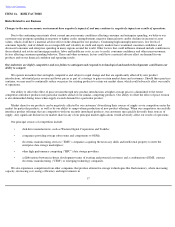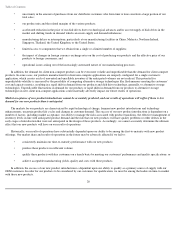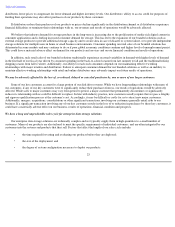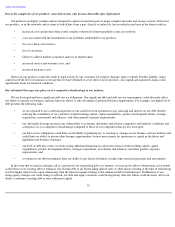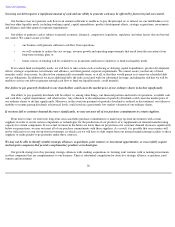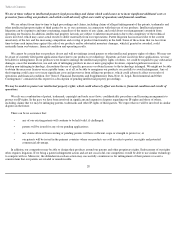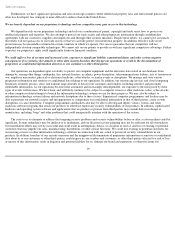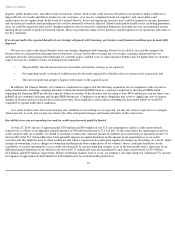Seagate 2013 Annual Report Download - page 28
Download and view the complete annual report
Please find page 28 of the 2013 Seagate annual report below. You can navigate through the pages in the report by either clicking on the pages listed below, or by using the keyword search tool below to find specific information within the annual report.
Table of Contents
Due to the complexity of our products, some defects may only become detectable after deployment.
Our products are highly complex and are designed to operate in and form part of larger complex networks and storage systems. Defects in
our products, or in the networks and systems of which they form a part, directly or indirectly, have resulted in and may in the future result in:
• increased costs and product delays until complex solution level interoperability issues are resolved;
• costs associated with the remediation of any problems attributable to our products;
• loss of or delays in revenues;
• loss of customers;
• failure to achieve market acceptance and loss of market share;
• increased service and warranty costs; and
• increased insurance costs.
Defects in our products could also result in legal actions by our customers for property damage, injury or death. Product liability claims
could exceed the level of insurance coverage that we have obtained to cover defects in our products. Any significant uninsured claims could
significantly harm our financial condition.
Our substantial leverage may place us at a competitive disadvantage in our industry.
We are leveraged and have significant debt service obligations. Our significant debt and debt service requirements could adversely affect
our ability to operate our business and may limit our ability to take advantage of potential business opportunities. For example, our high level of
debt presents the following risks:
• we are required to use a substantial portion of our cash flow from operations to pay principal and interest on our debt, thereby
reducing the availability of our cash flow to fund working capital, capital expenditures, product development efforts, strategic
acquisitions, investments and alliances, and other general corporate requirements;
• our substantial leverage increases our vulnerability to economic downturns and adverse competitive and industry conditions and
could place us at a competitive disadvantage compared to those of our competitors that are less leveraged;
•
our debt service obligations could limit our flexibility in planning for, or reacting to, changes in our business and our industry and
could limit our ability to pursue other business opportunities, borrow more money for operations or capital in the future and
implement our business strategies;
• our level of debt may restrict us from raising additional financing on satisfactory terms to fund working capital, capital
expenditures, product development efforts, strategic acquisitions, investments and alliances, and other general corporate
requirements; and
• covenants in our debt instruments limit our ability to pay future dividends or make other restricted payments and investments.
In the event that we need to refinance all or a portion of our outstanding debt as it matures, we may not be able to obtain terms as favorable
as the terms of our existing debt or refinance our existing debt at all. If prevailing interest rates or other factors existing at the time of refinancing
result in higher interest rates upon refinancing, then the interest expense relating to the refinanced debt would increase. Furthermore, if any
rating agency changes our credit rating or outlook, our debt and equity securities could be negatively affected, which could adversely affect our
ability to refinance existing debt or raise additional capital.
25




